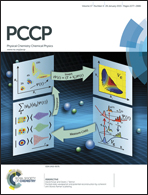Functionalization of nanostructured cerium oxide films with histidine
Abstract
The surfaces of polycrystalline cerium oxide films were modified by histidine adsorption under vacuum and characterized by the synchrotron based techniques of core and valence level photoemission, resonant photoemission and near edge X-ray absorption spectroscopy, as well as atomic force microscopy. Histidine is strongly bound to the oxide surface in the anionic form through the deprotonated carboxylate group, and forms a disordered molecular adlayer. The imidazole ring and the amino side group do not form bonds with the substrate but are involved in the intermolecular hydrogen bonding which stabilizes the molecular adlayer. The surface reaction with histidine results in water desorption accompanied by oxide reduction, which is propagated into the bulk of the film. Previously studied, well-characterized surfaces are a guide to the chemistry of the present polycrystalline surface and histidine bonds via the carboxylate group in both cases. In contrast, bonding via the imidazole group occurs on the well-ordered surface but not in the present case. The morphology and structure of the cerium oxide are decisive factors which define the adsorption geometry of the histidine adlayer.


 Please wait while we load your content...
Please wait while we load your content...